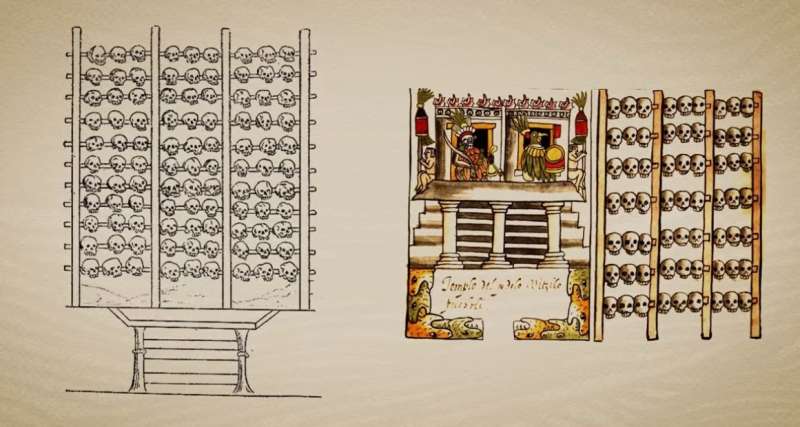June 28, 2018 report
Skull tower and skull rack offer evidence of Aztec human sacrifice in early Mexico City

A team of researchers has uncovered what they describe as a skull rack—a basketball court length wall of skulls with poles passed through them—in Mexico City. Lizzie Wade, with ScienceMag, outlines the work being done by a team from Mexico's National Institute of Anthropology and History.
Three years ago, the researchers uncovered what has been described as a skull tower—a circular tower built using skulls held together with mortar. The tower was found to be part of a trophy rack area that more recently, the researchers found, includes a skull rack.
The skull rack was found to be approximately 35 meters in length and approximately five meters high. It once consisted of wood posts at either end with smaller posts spaced every few meters between them. Wooden poles stretched horizontally between the posts. It would have looked like a high wooden fence. But it was used instead to hold human skulls—each had holes bored on either side to allow for sliding them onto a pole, like beads on an abacus. The wood was decayed, of course, but evidence found at the site allowed the team to piece together the original structure, along with the skulls. The researchers note that such a rack was believed to exist due to writings by Spanish explorers—they called it the tzompantli.
The researchers believe both the tower and rack were part of human sacrifice rituals, carried out to preserve the Aztec way of life. The dig site is located at Tenochtitlan, the center of an Aztec civilization, in a part of what is now modern Mexico City. The Mexica people lived there from approximately the 14th to the 16th centuries. When Spanish explorers arrived, they found the native people and their practices barbaric and knocked down many of their structures and covered over others.
As the excavations have continued, the team has been finding clues regarding the makeup of the entire area, which is believed to have been a temple. They now believe that the skull tower has a twin nearby, but have yet to find it. They plan to continue excavating and to further study the skulls and other artifacts to learn more about the culture of the people who lived there, including those who were sacrificed.
More information: Lizzie Wade. Feeding the gods: Hundreds of skulls reveal massive scale of human sacrifice in Aztec capital, Science (2018). DOI: 10.1126/science.aau5404
Journal information: Science
© 2018 Phys.org




















